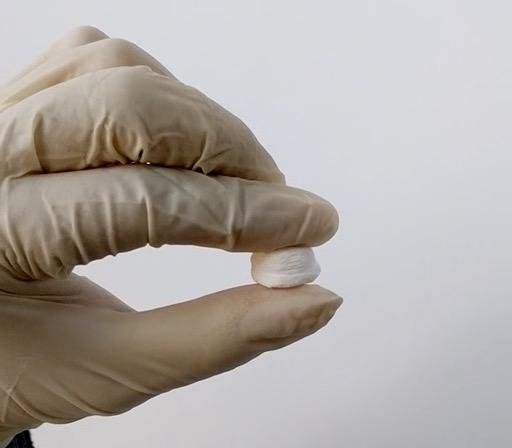
[Image above] Credit: Gao, Li, Wu, Brown; Tsinghua University
When you think of ceramic materials, attributes that immediately come to mind include solid, brittle, breakable, durable, insulating, and thermally-resistant.
Characteristics that don’t typically come to mind are soft, squishy, spongy, non-shattering, and flexible—but that’s about to change.
In a collaboration between Brown University and Tsinghua University in China, researchers have created small “sponges” out of ceramic nanofibers that are heat-resistant and highly deformable.
The researchers wanted to come up with a material that was “highly deformable but resistant to high temperatures,” Huajian Gao, Brown University School of Engineering professor and one of the researchers, says in a news release.
Through their research, Gao’s lab, along with Hui Wu’s and Xiaoyan Li’s lab at Tsinghua, discovered that ceramic materials behave differently on a nanoscale. They don’t crack or break—which is what typically happens to ceramics on a larger scale. In addition, Gao explained that the ceramic nanofibers they created have a tendency to creep—in other words, “enabling the material to deform without breaking,” he says.
The challenge the scientists initially faced lies within the creation of nanofibers. Wu’s previous method of electrospinning did not work well with ceramic materials, and 3-D laser printing was too costly. So he developed a method called blow-spinning—which uses air pressure to blow ceramic liquid through a tiny syringe. The liquid hardens into nanofibers and is then heated and collected in a small spongy ball.
Credit: Brown University; YouTube
Heat insulation and compression tests
After creating sponges from various oxide ceramic materials—including titanium dioxide, zirconium dioxide, yttria-stabilized zirconium dioxide, and barium titanate—the research team subjected them to compression tests. All sponges rebounded from being compressed up to 50%.
In addition, the team wanted to compare the insulating effects of the nanofiber sponges with various other materials, including glass, iron, and aluminum oxide. When flower petals were placed on top of each material, which was then heated to 400ºC (752ºF), only the nanofiber sponges were able to keep the flower petals from burning up.

Credit: Brown, Tsinghua Universities
This isn’t the first time scientists tried to apply the superpower of flexibility to ceramic materials. Nearly four years ago, MIT and Singapore researchers created flexible ceramic objects with a “memory” to return to their original shapes when bent and heated.
And back in 2014, materials scientists at Caltech produced flexible, three-dimensional hollow ceramic nanolattices that revert back to their original shape after being deformed.
More recently, we reported on a flexible ceramic developed by researchers from the University of Twente’s MESA+ Institute for Nanotechnology that resulted in a startup company after an infusion of seed money.
So why spend more time researching nanoscale ceramic behavior? The work could have a significant impact in industries that make insulated materials requiring flexibility, notes Gao in the release. He cites an example of insulated clothing for firefighters made out of their flexible ceramic material.
Clothing with that kind of insulating property could also be helpful for environmental researchers based in extremely cold climates.
Most important, Gao says, the method can be manufactured at a larger scale. “The method we use for doing it is inexpensive and scalable to make these in large quantities.”
The researchers provide an example of another use of their ceramic sponges—water purification. When a titanium dioxide sponge was placed in water containing a dye, it absorbed 50 times its weight and degraded the dye. Plus, they were able to reuse the sponge.
Perhaps eventually those sponges could help improve existing water filters for those in developing countries.
What other possibilities do you see for this unique ceramic nanofiber material?
Their open-access paper, published in Science Advances, is “Ultralight, scalable, and high-temperature–resilient ceramic nanofiber sponges” (DOI: 10.1126/sciadv.1603170).
